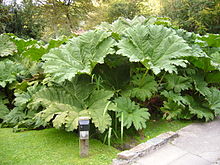bio.wikisort.org - Plant
Gunnera manicata, known as Brazilian giant-rhubarb[1] or giant rhubarb,[2] is a species of flowering plant in the family Gunneraceae from the coastal Serra do Mar Mountains of Santa Catarina, Parana and Rio Grande do Sul States, Brazil.[3][4]

It is a large, clump-forming herbaceous perennial growing to 2.5 m (8 ft) tall by 4 m (13 ft) or more. The leaves of G. manicata grow to an impressive size. Leaves with diameters well in excess of 120 cm (4 ft) are commonplace, with a spread of 3 m × 3 m (10 ft × 10 ft) on a mature plant.The largest on record had leaves up to eleven feet (3.3 meters) in width.[5] The underside of the leaf and the whole stalk have spikes on them. In early summer it bears tiny red-green, dimerous flowers in conical branched panicles, followed by small, spherical fruit. However, it is primarily cultivated for its massive leaves.[4] Like most Gunneras, it has a symbiotic relationship with certain blue-green algae which provide nitrogen by fixation.
This plant grows best in damp conditions such as near garden ponds, but dislikes winter cold and wet.[6]
Despite the common name "giant rhubarb", this plant is not closely related to true rhubarb. It was named after a Norwegian bishop and naturalist Johan Ernst Gunnerus, who also named and published a description about the basking shark.[citation needed]
It is native to the Serra do Mar mountains of coastal Santa Catarina and Rio Grande do Sul states, Brazil, where it is used in traditional medicine for sexually transmitted diseases.[7]
References
- BSBI List 2007 (xls). Botanical Society of Britain and Ireland. Archived from the original (xls) on 2015-06-26. Retrieved 2014-10-17.
- USDA, NRCS (n.d.). "Gunnera manicata". The PLANTS Database (plants.usda.gov). Greensboro, North Carolina: National Plant Data Team. Retrieved 6 January 2016.
- Wanntorp, Livia; Wanntorp, Hans-Erik; Källersjö, Mari (2002-08-01). "The identity of Gunnera manicata Linden ex André - resolving a Brazilian-Colombian enigma". Taxon. 51 (3): 493–497.
- RHS A-Z encyclopedia of garden plants. United Kingdom: Dorling Kindersley. 2008. p. 1136. ISBN 1405332964.
- The Garden Volume 63 issue 1831 (February 21, 1903) page 125
- "Gunnera manicata". RHS. Retrieved 22 March 2022.
- Mariotti, Kristiane de Cássia; Schuh, Roselena Silvestri; Matos Nunes, Jéssica de; Salamoni, Sabrina Pinto; Meirelles, Gabriela; Barreto, Fabiano; Von Poser, Gilsane Lino; Singer, Rodrigo Bustos; Dallegrave, Eliane; Van Der Sand, Sueli Teresinha; Limberger, Renata Pereira (Jan 2014). "Chemical constituents and pharmacological profile of Gunnera manicata L. extracts". Brazilian Journal of Pharmaceutical Sciences. 50 (1). Retrieved 20 December 2016.
External links
- Pink, A. (2004). Gardening for the Million. Project Gutenberg Literary Archive Foundation.
- Gunnera manicata
На других языках
- [en] Gunnera manicata
[ru] Гуннера влагалищная
Гуннера влагалищная[3] (лат. Gunnera manicata) — крупное травянистое растение семейства Гуннеровые (Gunneraceae).Другой контент может иметь иную лицензию. Перед использованием материалов сайта WikiSort.org внимательно изучите правила лицензирования конкретных элементов наполнения сайта.
WikiSort.org - проект по пересортировке и дополнению контента Википедии
